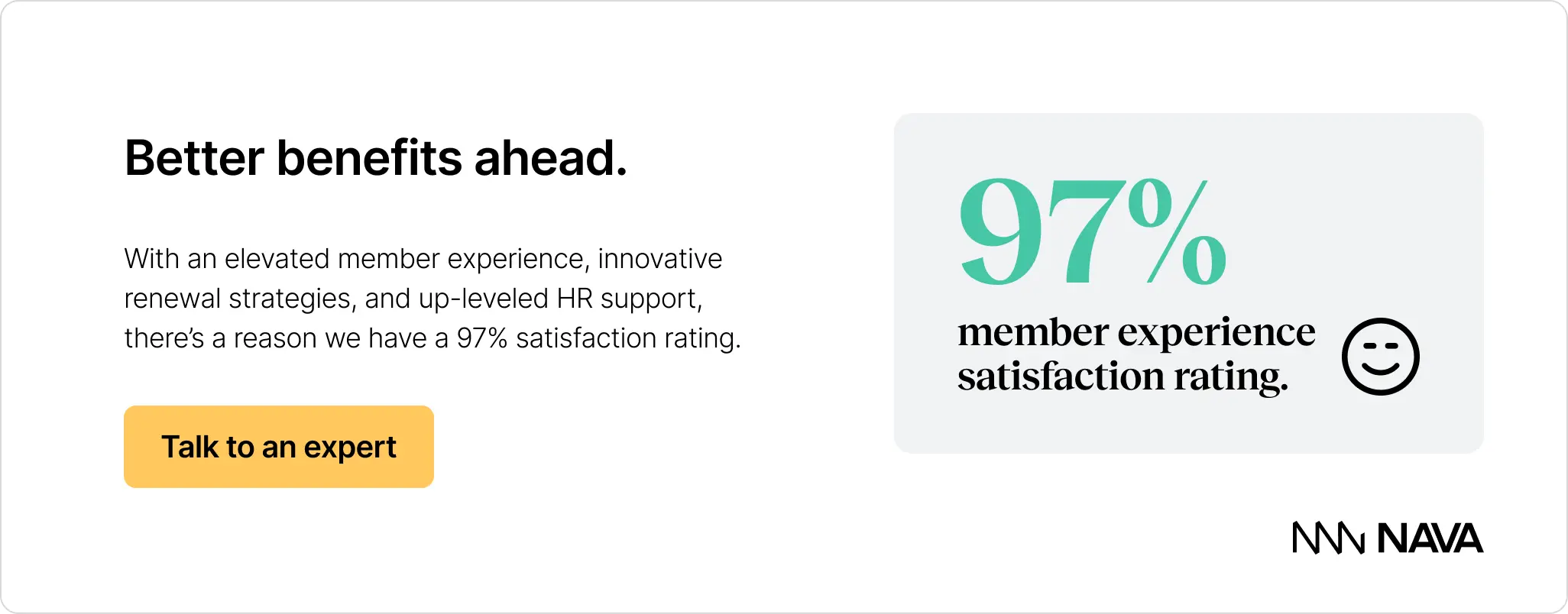What is an ICHRA? A complete guide to Individual Coverage HRAs for modern employers
.webp)
Healthcare costs are rising, and traditional group plans no longer fit today’s distributed workforce. This blog breaks down what an Individual Coverage Health Reimbursement Arrangement (ICHRA) is, how it works, and the key differences between ICHRAs and QSEHRAs. Drawing on insights from the recent Nava + Thatch webinar, it explores the pros and cons of this modern benefits model and how it helps employers control costs while giving employees real choice.
Healthcare costs keep climbing. Employee satisfaction, meanwhile, stays flat. For HR leaders, that’s an exhausting equation, especially when traditional group plans no longer match the needs of today’s distributed, multigenerational workforce.
At Nava, we recently hosted a webinar with Thatch, one of the leading technology platforms for modern health benefits, to unpack how Individual Coverage Health Reimbursement Arrangements (ICHRAs) are reshaping the benefits landscape. Drawing on insights from Mark Kubera, Head of Revenue at Thatch, and Marie Holmes, Solutions Consultant at Nava, this guide distills the most important takeaways for HR leaders who want a smarter, more flexible approach to health insurance.
The bottom line? ICHRAs offer a modern, customizable model that lets employers control costs while empowering employees to choose coverage that fits their unique needs.
If you’ve been exploring new funding models or searching for “what is an ICHRA,” this guide breaks down everything you need to know: what it is, why it’s gaining traction, how it works, its pros and cons, and how it compares to QSEHRA.
What is an ICHRA? (Individual Coverage Health Reimbursement Arrangement)
An ICHRA (pronounced “ick-rah”) is an employer-funded health benefit that allows employees to purchase individual health insurance with tax-free reimbursements from their employer.
Instead of choosing a single group plan for everyone, the employer sets a defined contribution: a fixed dollar amount that each employee can use to buy coverage that fits their needs and location.
It’s a shift from the old “defined benefit” model (where the employer picks the plan) to a defined contribution model (where the employer funds a budget, and the employee chooses).

Why ICHRAs are gaining momentum now
The ICHRA regulation, introduced in 2019, opened the door for employers to give workers pre-tax dollars to purchase their own coverage on the individual market.
Since then, the individual market has grown to cover more than 25 million Americans, with major carriers offering robust, ACA-compliant options in nearly every state.
At the same time, there’s bipartisan support for ICHRAs in Congress and broad industry momentum among small and mid-sized employers who want more flexibility without losing compliance.
For HR leaders, this timing matters: the market is mature, technology has caught up, and employee expectations for choice are higher than ever.
ICHRA pros and cons
Every benefits model has tradeoffs. Below is an honest look at the pros and cons of ICHRAs, based on Nava and Thatch’s experience supporting clients through this transition.
Pros of ICHRAs
1. Predictable budgeting
Employers define a fixed monthly contribution, making healthcare costs easier to forecast year-over-year.
2. Employee choice
Employees can choose their own carrier and plan, which is nearly impossible under traditional group insurance.
3. Flexibility for remote teams
ICHRAs work especially well for distributed workforces, since each employee can buy coverage in their own zip code.
4. Compliance-friendly
When implemented through a partner like Thatch, ICHRAs are fully ACA-compliant and handle all necessary filings.
5. Sustainable cost trends
The individual market has shown more stable premiums compared to group renewals, which often increase by double digits each year.
Cons of ICHRAs
1. Learning curve
Employees and leadership need education on how the model works, which can require upfront communication and support.
2. Less centralized carrier contact
Since employees may choose different carriers, employers rely on their ICHRA platform (like Thatch) for centralized support.
3. Varying local rates
Premiums depend on employee age and location, which can create cost differences across your workforce.
4. Change management
Transitioning to a new funding model takes buy-in across HR, finance, and leadership, but with the right guidance, the process is smooth.
Overall, the advantages outweigh the drawbacks for organizations that value flexibility, predictability, and a better employee experience.
ICHRA vs QSEHRA: What’s the difference?
HR leaders often ask, “What’s the difference between a QSEHRA and an ICHRA?” Both are forms of Health Reimbursement Arrangements (HRAs)—employer-funded benefits that reimburse employees for health insurance premiums and other medical expenses—but they serve different types of employers.
QSEHRA, short for Qualified Small Employer Health Reimbursement Arrangement, is designed specifically for small employers who don’t offer a traditional group health plan. It allows companies with fewer than 50 full-time employees to reimburse employees tax-free for individual health insurance premiums and eligible medical costs, up to annual limits set by the IRS.
ICHRA, or Individual Coverage Health Reimbursement Arrangement, takes that concept further. It’s available to employers of any size and allows greater flexibility, with no annual reimbursement caps, multiple employee classes, and the ability to replace group health coverage altogether.

In short:
- QSEHRA is ideal for smaller employers just getting started with benefits.
- ICHRA scales with you. It’s perfect when you’re expanding across states, managing diverse employee needs, or seeking predictable long-term costs.
If you’ve outgrown QSEHRA or want more control over plan design, transitioning to an ICHRA is often the natural next step.
How ICHRAs empower employees
Beyond cost control, ICHRAs transform how employees experience their health benefits.
During our webinar, Mark Kubera shared a story that perfectly illustrates this shift. When his wife was expecting, he used his ICHRA to choose a health plan that included their preferred hospital and OB provider. With leftover funds, he covered out-of-pocket costs related to their baby’s arrival.
That kind of personalization simply isn’t possible with a traditional group plan. Instead of being stuck with one-size-fits-all coverage, employees can select the plan and network that best match their needs, stage of life, and location.
For HR leaders, this story captures the core promise of ICHRAs: flexibility for employees, predictability for employers, and a better experience for both.

How ICHRAs actually work
Here’s what the process looks like in practice:
1. Set the contribution
Employers decide how much to contribute per employee or per employee class (e.g., full-time vs part-time).
2. Employees choose coverage
Employees use their allowance to shop for individual health insurance on the marketplace or through an ICHRA partner like Thatch.
3. Platform handles administration
The system manages enrollment, payroll deductions, billing, and compliance automatically.
4. Employees use leftover funds
Any unused dollars can go toward qualified medical expenses like deductibles, copays, or wellness programs.
The result: employees get personalization and transparency, while HR teams get a streamlined, compliant process.
Who should consider an ICHRA?
ICHRAs aren’t a one-size-fits-all solution, but they can be transformative for the right employer.
You might be a strong candidate if your organization:
- Faces high renewal increases or volatile claims experience
- Employs a distributed or remote workforce across states
- Is growing quickly and needs predictable, scalable benefits
- Wants to give employees more choice in their healthcare coverage
If your workforce is small, localized, and satisfied with your current plan, a traditional group plan or QSEHRA may still make sense.
Common ICHRA compliance questions, answered
Are ICHRAs ACA-compliant?
Yes. All ICHRA plans offered through Thatch are fully ACA-compliant, covering essential health benefits.
Can contributions vary by employee?
Yes, but only within defined “classes” (e.g., full-time vs part-time, geographic, or seasonal).
How do you ensure affordability?
The platform automatically runs ACA affordability tests based on salary data, ensuring compliance.
What about documentation?
Thatch handles all required documentation, including plan documents, COBRA, and 1095-C filings.
How Nava and Thatch simplify ICHRA implementation
Implementing an ICHRA might sound complex, but it doesn’t have to be.
- Nava’s role: Strategic consulting. We help you assess whether an ICHRA is right for your organization, model financial scenarios, and align leadership buy-in.
- Thatch’s role: Technology and compliance. Their platform automates enrollment, billing, payroll integration, and employee support.
Together, we deliver a turnkey experience, from initial evaluation to employee education to ongoing support.
Implementation typically takes 1–3 months.
Getting started: how to evaluate an ICHRA
If you’re considering an ICHRA, here’s a roadmap:
- Consult your broker or benefits consultant. Identify your cost pain points and workforce structure.
- Model the numbers. Compare your current group plan costs to a defined-contribution approach.
- Educate leadership early. Finance and executives need to understand the strategic shift.
- Choose the right partner. Look for end-to-end support (technology, compliance, employee experience).
- Plan your rollout. With the right partner, implementation can happen smoothly before your next renewal.
The future of employer-sponsored health benefits
As the workforce continues to evolve, so must our approach to employee benefits. ICHRAs represent the next generation of employer-sponsored healthcare: flexible, predictable, and built for modern organizations.
For HR leaders, that means less time firefighting renewals and more time building a benefits program that actually works for everyone.
Ready to explore whether an ICHRA is right for your organization? Connect with Nava’s benefits experts to model what this could look like for your team.






.png)
.webp)